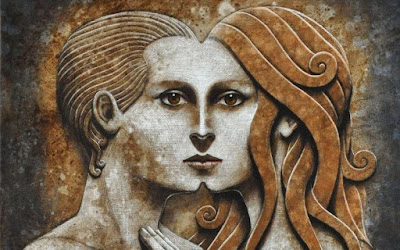The Philosophy of Premam - Chapter Two - Butterflies are Mentally Mental and So Is Anima
Hey there imaginary friend! For this post, we'll be tackling a central theme in Premam using one of Jung's most interesting theories on the human psyche; the anima. So fasten your seat-belts and don't be a-Freud; this is going to be a bumpy ride!
The Anima
The Anima
- Eve - Largely based on the mother figure; biological, instinctive and eventually destructive
- Helen of Troy - a collective and ideal sexual image
- Mary - manifests in religious feelings and a capacity for genuine friendships
- Sophia - called Wisdom in the Bible; acts as a guide to the inner self, mediating to consciousness the contents of the unconscious
Advice From A Caterpillar
Premam uses an overarching leitmotif of a butterfly to signify George's evolution in love. The film's title itself is symbolized as a butterfly and to keen eyes, a butterfly appears at key instances in the plot.
The butterfly, throughout human history, is the symbol of change, endurance, hope and life. Its ability to completely alter its morphology has always intrigued mankind. In Christianity, the butterfly is used as metaphor for the resurrection; In Hinduism, it symbolizes the ethos of reincarnation.
In Premam, however, it is used as a symbol for it's view on love. A butterfly, apart from change, doesn't use all it's resources on a single flower; it learns to shift it's perspective and grow in wisdom. As it is chanted in Ithu Puthan Kaalam, the first melody in the film, "ഈ ലോകത്തില് മറക്കാന് പഠിക്കുമ്പോഴും; സഹിക്കാന് മഠിക്കുമ്പോഴും ചിരിക്കാന് മറക്കല്ലേ നീ" which roughly translates to, 'In this modern world, whenever one tries to forget one's own troubles, one should also not forget to smile through one's own suffering'. George's life revolves not only around forgetting suffering, but ultimately evolving in maturity and endurance by utilising it. One should let the universe drive oneself to its preordained path.
This is similar to what the existentialist philosopher Søren Kierkegaard elucidated in his works; “Every human being must learn to be anxious in order that he might not perish either by never having been in anxiety or by succumbing in anxiety. Whoever has learned to be anxious in the right way has learned the ultimate.” According to Kierkegaard, who'd lost his own family at a young age, suffering gives an individual an opportunity to spiritually evolve; by courageously facing suffering, one can find great joy in life.
Whenever George enters into a relationship, a butterfly appears in frame.
Similarly, whenever George leaves one, a butterfly is seen flying away.
The butterfly can also properly be considered a metaphor for George's anima in his relationships.
Initially, George's Jung (pun-intended) anima is an amalgamation of the stages 'Eve' and 'Helen'. His first rite of passage is confronting a slice of his shadow through Mary. Mary, according to George, is everything he wishes for. He was, what Jung would say, projecting his anima on Mary. Mary resembles his unconscious idea of the perfect woman through his anima. However, such an anima is destructive. Men with an anima of this type cannot function well without a vital connection to a woman and is easy prey to being controlled by her, as it is with all the men in his neighborhood. George does have his heart broken due to his unrealistic and naive expectations of love and this leads to a psychological transference to his future confrontations with love.
In the second act, George's anima confronts Malar. At this stage, his anima has developed beyond Eve, and has become Helen, seeking hedonistic adventures and pleasures. Malar, deliberately chosen, is the Malayalam word for 'flower'. She grounds the risque George and helps him construct a capacity for lasting relationships. She is the projection of Mary (the anima) in his life. George with an anima of this kind is able to see Malar as she is, independent of his own needs. His sexuality is integrated into his life and is not an autonomous instinct that drives him.
In the third act, George meets Celine. After the tribulations in the second act, George's anima seeks to be Sophia. Celine signifies the end to George's search for the self. With Celine, there does not appear to be an butterfly flying away into oblivion. His ego, finally grounded, seeks to unify the conscious and the unconscious through marriage.
Sophia is behind man's need to grapple with the grandest of philosophical issues, the search for meaning. His anima's final transformation is a continuing process, sharing his life with a companion in their mutual search for the meaning of life, the universe, and everything (The answer is 42, if you were wondering). As the film itself concludes, "God unified the flowers which cannot travel with the butterflies, and for ye flowers which can, He bestowed upon thee with butterflies as the emotion of love!"
Fin.









Wow.....
ReplyDeleteSimply superb
ReplyDeleteAwesome
ReplyDeleteChanced upon this while searching for something more on 'butterfly is mentally mental and so is love'.
ReplyDeleteThis is beautiful.
Hope to read more from you.
P.S. didn't see any new posts.
don't stop writing, my friend.
Superb👌🏻👌🏻
ReplyDeleteAmazed!
ReplyDelete